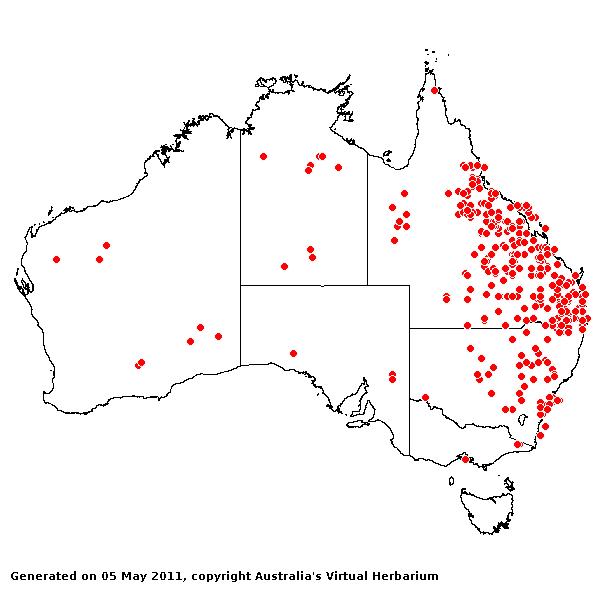Paspalidium gracile (R.Br.) D.K.Hughes. Bull.
Misc. Inform. 318 (1923).
Classification. (GPWG 2001) : Subfamily
Panicoideae. Paniceae.
Basionym and/or
Replacement Name: Panicum gracile
R. Br., Prodr. 190 (1810).
Key references
(books and floras): [1810]. R.Brown, Prodromus (190 as Panicum
gracile), [1878] G.Bentham, Flora Australiensis 7 (475 as Panicum
gracile), [1952] C.A.Gardner, Flora of Western Australia 1 Gramineae
(249), [2002] D.Sharp & B.K.Simon, AusGrass, Grasses of Australia,
[2008] S.W.L.Jacobs, R.D.B.Walley & D.J.B.Wheeler, Grasses of New South
Wales (324).
Illustrations:
[1952] C.A.Gardner, Flora of Western Australia 1 Gramineae (247,
Pl. 73), [2008] S.W.L.Jacobs, R.D.B.Whalley & D.J.B.Wheeler, Grasses of
New South Wales, 4th edn (324).
Habit.
Perennial. Rhizomes present, short. Culms erect, 10–90 cm tall, wiry, 5–10
-noded. Mid-culm internodes solid or spongy, glabrous or pubescent. Mid-culm
nodes glabrous or pubescent. Lateral branches sparsely branched or branched.
Leaf-sheaths glabrous on surface or hairy. Ligule a fringed membrane or a
fringe of hairs, 1–1.25 mm long. Leaf-blades filiform, convolute, 7–14 cm long,
1–4 mm wide. Leaf-blade surface scabrous, glabrous or indumented.
Inflorescence.
Inflorescence compound, a panicle of racemes. Racemes 5–10, appressed, 1–3 cm
long, 1.5–4 mm wide, bearing 5–12 fertile spikelets on each. Central
inflorescence axis 5–20 cm long.
Spikelets.
Spikelets pedicelled. Fertile spikelets 2-flowered, the lower floret barren
(rarely male), the upper fertile, comprising 1 basal sterile florets,
comprising 1 fertile floret(s), without rachilla extension, elliptic or
obovate, laterally compressed or dorsally compressed, 2–3.2 mm long. Rhachilla
internodes elongated between glumes, elongated below basal sterile floret, and
elongated between basal sterile florets.
Glumes.
Glumes thinner than fertile lemma. Lower glume oblate, membranous, without
keels, 3–5 -nerved. Lower glume surface glabrous. Lower glume apex muticous or
mucronate. Upper glume orbicular, 1.9–2.7 mm long, membranous, without keels,
5–7 -nerved. Florets. Basal sterile florets 1, barren, without
significant palea. Lemma of lower sterile floret 100 % of length of spikelet,
membranous, 5 -nerved.
Fertile lemma 2–3 mm
long, without keel, 5 -nerved. Lemma apex mucronate.
Continental
Distribution: Australasia.
Australian
Distribution: Western Australia, Northern Territory, South Australia,
Queensland, New South Wales, Victoria.
Western Australia:
Austin. Eucla, Coolgardie. Northern Territory: Barkly Tableland. South
Australia: Nullabor, Eastern. Queensland: Burke, Burnett, Cook,
Darling Downs, Gregory North, Leichhardt, Maranoa, Mitchell, Moreton, North
Kennedy, Port Curtis, South Kennedy, Warrego, Wide Bay, Gregory South. New
South Wales: Central Coast, Northern Tablelands, Central Tablelands,
Southern Tablelands, North-Western Slopes, Central-Western Slopes,
North-Western Plains. Victoria: East Gippsland, Gippsland Plain.
Notes.
The distinction among P. gracile, P. constrictum and P. criniforme
seems arbitrary.
In tropical and
subtropical wet sclerophyll forests, Brigalow forests, tropical and subtropical
sub-humid woodlands, temperate sub-humid woodlands, semi-arid shrub woodlands,
acacia shrublands, and arid tussock grasslands. Flowers mostly Mar.-July.






